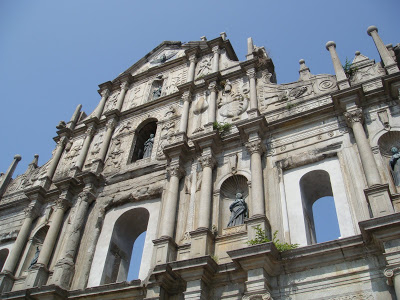 Welcome to Macau! Portugal tried to offload this former colony to the People’s Republic of China in the 1970s, but China’s official response was, “Oooooh, you shouldn’t have….” Just as we exited immigration a bus went by with a banner reading, “Macau! City of Dreams!” and another tourist said, “I’m pretty sure that slogan is already taken.”
Welcome to Macau! Portugal tried to offload this former colony to the People’s Republic of China in the 1970s, but China’s official response was, “Oooooh, you shouldn’t have….” Just as we exited immigration a bus went by with a banner reading, “Macau! City of Dreams!” and another tourist said, “I’m pretty sure that slogan is already taken.” 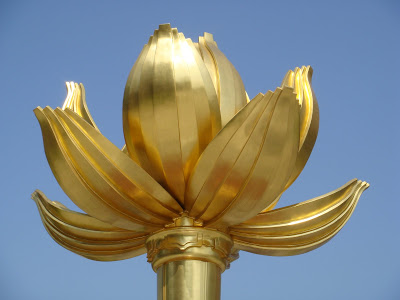 The first tourists to Macau were refugees fleeing from the Mongolian hoards during the Southern Song Dynasty, whenever that was, but nothing happened until the Portuguese sailed in during the 1500s. They set up a little town and paid rent (500 taels of silver annually).
The first tourists to Macau were refugees fleeing from the Mongolian hoards during the Southern Song Dynasty, whenever that was, but nothing happened until the Portuguese sailed in during the 1500s. They set up a little town and paid rent (500 taels of silver annually).  A century later the Dutch tried unsuccessfully to conquer Macau, also known as Aomen, although they did leave a Dutch Quarter. Then Macau was involved in the Opium War where Britain yoinked Hong Kong from China, and finally a few decades later in 1887 the Qing Dynasty signed the Sino-Portuguese Treaty of Amity and Commerce, whereby China let the Portuguese have Macau as a colony and Portugal promised not to give it to any other countries.
A century later the Dutch tried unsuccessfully to conquer Macau, also known as Aomen, although they did leave a Dutch Quarter. Then Macau was involved in the Opium War where Britain yoinked Hong Kong from China, and finally a few decades later in 1887 the Qing Dynasty signed the Sino-Portuguese Treaty of Amity and Commerce, whereby China let the Portuguese have Macau as a colony and Portugal promised not to give it to any other countries. 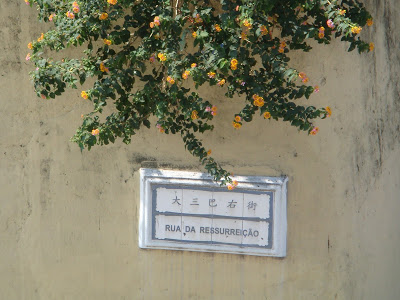 So more accurately, what happened in the 1970s is that the Salazar dictatorship was overthrown in Lisbon, so the Portuguese decided to do away with all foreign colonies, turning Macau into a red-headed stepchild of a colony, or, officially, a “Chinese territory under the temporary Portuguese administration,” until the official hand-off in 1999, when China gave it that big golden lotus flower just like Hong Kong’s to celebrate their Special Administration Region (SAR) status.
So more accurately, what happened in the 1970s is that the Salazar dictatorship was overthrown in Lisbon, so the Portuguese decided to do away with all foreign colonies, turning Macau into a red-headed stepchild of a colony, or, officially, a “Chinese territory under the temporary Portuguese administration,” until the official hand-off in 1999, when China gave it that big golden lotus flower just like Hong Kong’s to celebrate their Special Administration Region (SAR) status. 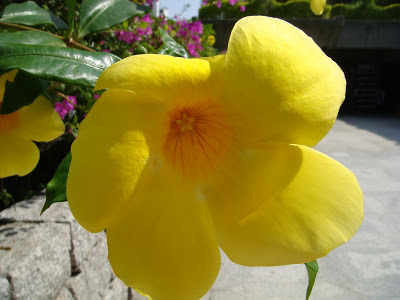 Anywho, so Chris and I took an hour-long ferry to Macau one morning because Chris thought it would be cool and I’d heard you could get excellent cheap olive oil and Portuguese wine. We saw neither, but we had a good time. Less than 5% of the population is NOT Chinese. Only 2% are Portuguese. Despite the Portuguese translations on the Chinese road signs, the church facade and the Dutch quarter, it felt more ‘China’ than ‘Europe,’ probably because of the population.
Anywho, so Chris and I took an hour-long ferry to Macau one morning because Chris thought it would be cool and I’d heard you could get excellent cheap olive oil and Portuguese wine. We saw neither, but we had a good time. Less than 5% of the population is NOT Chinese. Only 2% are Portuguese. Despite the Portuguese translations on the Chinese road signs, the church facade and the Dutch quarter, it felt more ‘China’ than ‘Europe,’ probably because of the population. 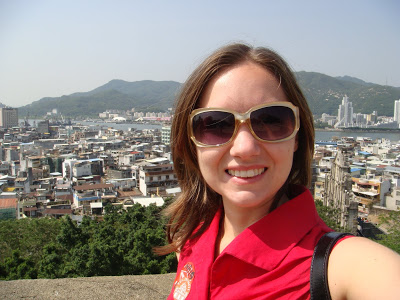 Oh wait, here’s a European-ish street and scooter. The scooter is parked in front of the old city walls, which lead to a Chinese temple. Asia is Asia, but if you’re looking for European flair I recomment the very Dutch-feeling Nagasaki or really Ebisu in Tokyo.
Oh wait, here’s a European-ish street and scooter. The scooter is parked in front of the old city walls, which lead to a Chinese temple. Asia is Asia, but if you’re looking for European flair I recomment the very Dutch-feeling Nagasaki or really Ebisu in Tokyo. 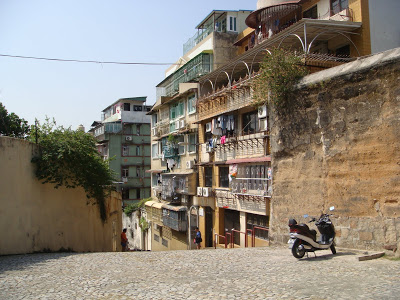
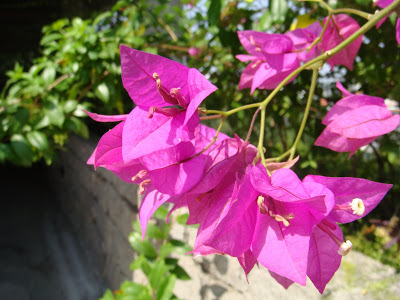 I was most excited about the ruins of St. Paul’s Cathedral, which was completed in 1602 but consumed by fire in 1835. The lone southern wall was left standing and is now reinforced so you can climb some steel steps and peek through the windows in case you want to be in a lot of vacation photos. This good-looking couple was in a LOT of people’s vacation photos.
I was most excited about the ruins of St. Paul’s Cathedral, which was completed in 1602 but consumed by fire in 1835. The lone southern wall was left standing and is now reinforced so you can climb some steel steps and peek through the windows in case you want to be in a lot of vacation photos. This good-looking couple was in a LOT of people’s vacation photos. 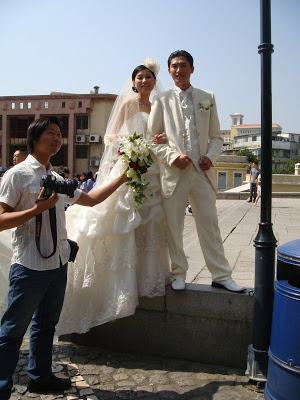 Inside the Museo de Macau next door to the ruins and saw some old Portuguese maps and bells that used to hang in the cathedral. A 1736 bell that used to hang in the Bell Tower of the Church of Mater Dei was inscribed, “SONET VOX TVA IN AVRIBVS MEIS” meaning, “Your voice resounds in my ears.” I like that.
Inside the Museo de Macau next door to the ruins and saw some old Portuguese maps and bells that used to hang in the cathedral. A 1736 bell that used to hang in the Bell Tower of the Church of Mater Dei was inscribed, “SONET VOX TVA IN AVRIBVS MEIS” meaning, “Your voice resounds in my ears.” I like that. 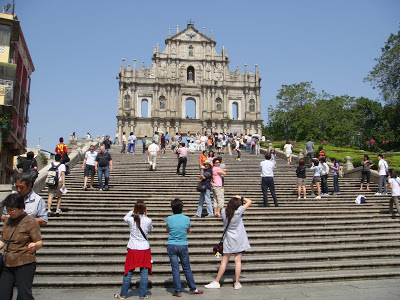
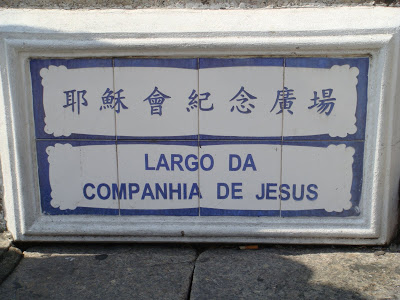 Also notable was a plaque I read about how Macau was affected by World War II. I had no idea at the…worldwide…extent of WWII until seeing memorials in Nagasaki…and Singapore…and Macau…and Chris in the Philippines: “Sheltered from the horrors of war, Macau became a haven flooded by waves of refugees. in 1941, the population–which had been growing steadily since 1937 due to the Sino-Japanese War–leapt from 150,000 to half a million. Those without relatives or friends were sheltered in hospitals and homes, schools, clubs and churches which expanded until they were bursting at the seams. The stream of unfortunate souls was so heavy that even the streets were soon filled with people, especially children and the elderly, sheltering precariously beneath the arcades. Welfare institutions and residents all did their best to help those who were collapsing from hunger, cold, exhaustion and bad fortune, comforting some with soup and rice, others with treatment, clothing and care. During the period of the Sino-Japanese War, the people of Macau actively participated in donating and offering, and even sending people to China to give support.”
Also notable was a plaque I read about how Macau was affected by World War II. I had no idea at the…worldwide…extent of WWII until seeing memorials in Nagasaki…and Singapore…and Macau…and Chris in the Philippines: “Sheltered from the horrors of war, Macau became a haven flooded by waves of refugees. in 1941, the population–which had been growing steadily since 1937 due to the Sino-Japanese War–leapt from 150,000 to half a million. Those without relatives or friends were sheltered in hospitals and homes, schools, clubs and churches which expanded until they were bursting at the seams. The stream of unfortunate souls was so heavy that even the streets were soon filled with people, especially children and the elderly, sheltering precariously beneath the arcades. Welfare institutions and residents all did their best to help those who were collapsing from hunger, cold, exhaustion and bad fortune, comforting some with soup and rice, others with treatment, clothing and care. During the period of the Sino-Japanese War, the people of Macau actively participated in donating and offering, and even sending people to China to give support.” 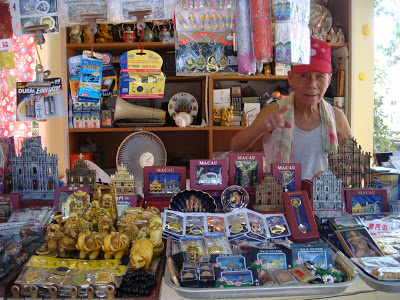 These days, people are more likely to rush to Macau for the casinos, a booming new industry that attracts mostly Chinese gamblers to the Las Vegas of Asia. The museum said: “Gambling has long been a popular tradition amongst the Chinese being imperative within the financial and economic context of the territory. The so-called Chinese games are played in Macau from dates that are difficult to confirm. Amongst the various games in Fantan, which should be the eldest having originated from the 19th century. The first concessionaire negotiated with the administration their first contract in 1961 and started operating on the 1st of January 1962. Gambling is carried out all year round but it is during the period of Chinese New Year that the casinos of the territory register the highest income. The activity is an integral part of Macao’s tourism. The gambling industry plays a leading role in the Macao economy.” Macau and Macao are both correct, by the way. I think the wording on that sign is amusing. It should be the oldest…
These days, people are more likely to rush to Macau for the casinos, a booming new industry that attracts mostly Chinese gamblers to the Las Vegas of Asia. The museum said: “Gambling has long been a popular tradition amongst the Chinese being imperative within the financial and economic context of the territory. The so-called Chinese games are played in Macau from dates that are difficult to confirm. Amongst the various games in Fantan, which should be the eldest having originated from the 19th century. The first concessionaire negotiated with the administration their first contract in 1961 and started operating on the 1st of January 1962. Gambling is carried out all year round but it is during the period of Chinese New Year that the casinos of the territory register the highest income. The activity is an integral part of Macao’s tourism. The gambling industry plays a leading role in the Macao economy.” Macau and Macao are both correct, by the way. I think the wording on that sign is amusing. It should be the oldest…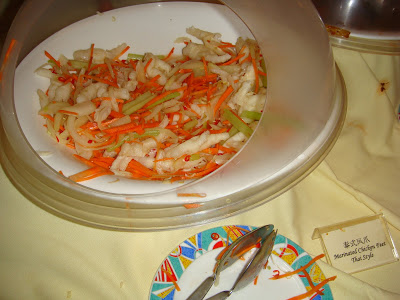 And here are some Marinated Chicken Feet Thai Style at our lunch buffet, which reminded me of this September New York Times article that my parents and I got a kick out of: Chewy Chicken Feet May Quash a Trade War, which reads in part: “China is threatening to cut off imports of American chicken, but poultry experts have at least one reason to suspect it may be an empty threat: Many Chinese consumbers would miss the scrumptions chicken feet they get from this country. ‘We have these jumbo, juicy paws the Chinese really love,’ said Paul W. Aho, a poultry economist and consultant.” ha ha! The end.
And here are some Marinated Chicken Feet Thai Style at our lunch buffet, which reminded me of this September New York Times article that my parents and I got a kick out of: Chewy Chicken Feet May Quash a Trade War, which reads in part: “China is threatening to cut off imports of American chicken, but poultry experts have at least one reason to suspect it may be an empty threat: Many Chinese consumbers would miss the scrumptions chicken feet they get from this country. ‘We have these jumbo, juicy paws the Chinese really love,’ said Paul W. Aho, a poultry economist and consultant.” ha ha! The end.
Where Globe-Trotting meets Beach-Combing
